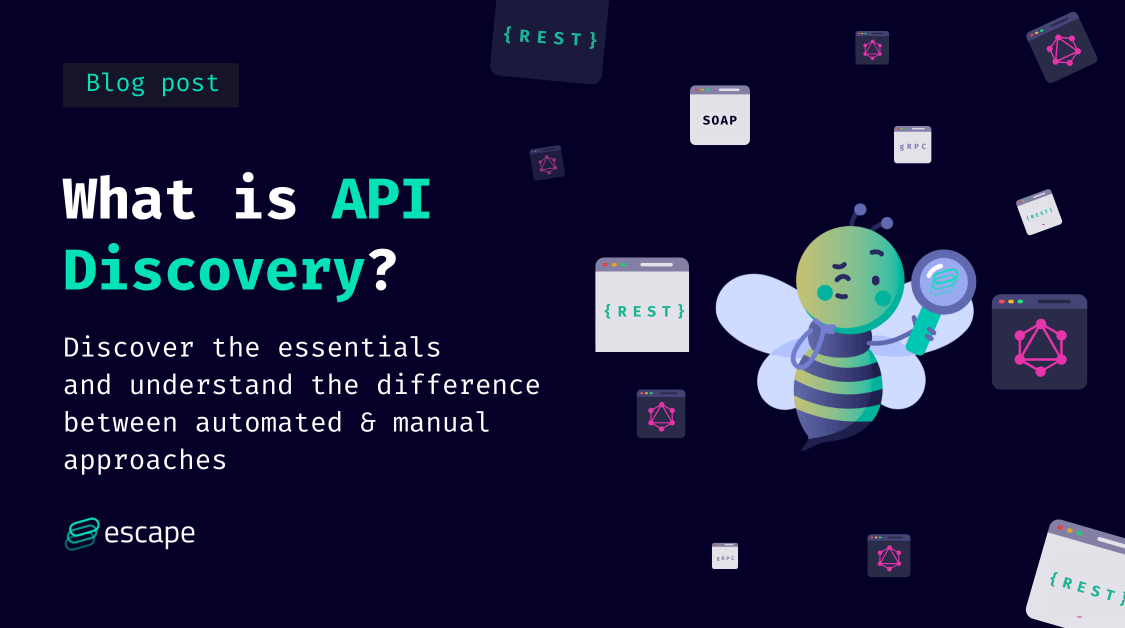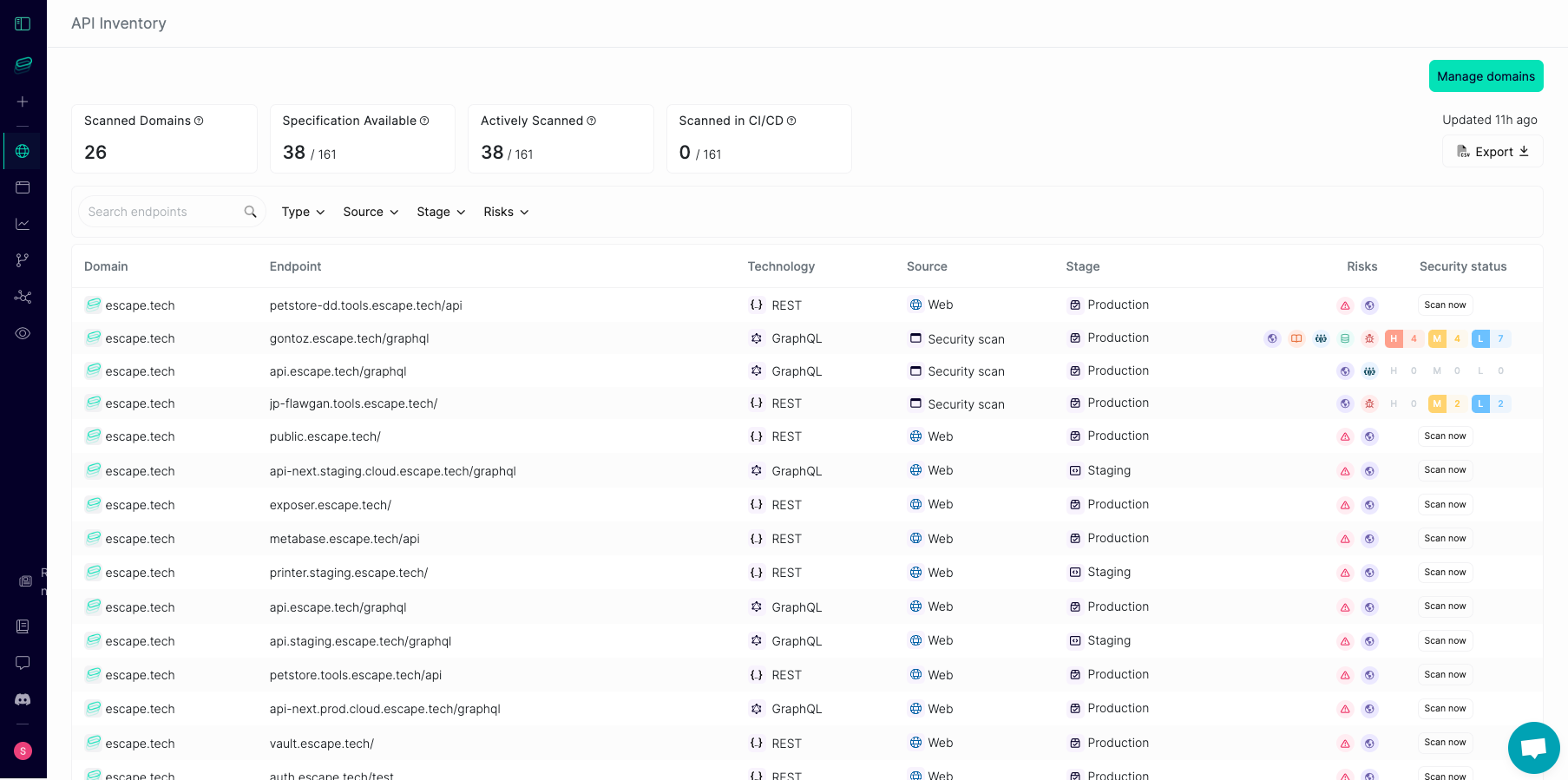What is API discovery, and how does it work?

Ever wondered how applications effortlessly communicate and collaborate, seamlessly sharing data and functionalities? Enter API discovery – the game-changer in modern development. What if finding and connecting with APIs was as intuitive as flipping a switch?
As the newly appointed security engineer, you quickly realize the sprawling web of APIs that power the company's services and pose unseen vulnerabilities. Every undocumented API feels like a ticking time bomb, a potential gateway for malicious breaches.
To ensure that the organization's data and services remain protected and bridge the gap between innovation and security, your top priority is to create a comprehensive inventory of all used APIs. This article dives into the significance of API discovery, unlocking the key to streamlined integration, accelerated innovation, and the boundless benefits it brings.
Why is API discovery important?
API discovery is crucial as it simplifies seamless integration between systems and services. It enables developers to efficiently find and understand available APIs, fostering innovation, collaboration, and the creation of powerful, interconnected applications. Easy API discovery streamlines development processes, accelerates time-to-market, and enhances overall system interoperability.
Why is API discovery needed for application security engineers?
As an Application Security engineer, the API discovery would be particularly useful for:
- Security Audits: API discovery tools can help identify all APIs being used within an organization, including Zombie and Shadows APIs. Having a comprehensive list ensures that no API is left out during security assessments.
- Risk Assessment: With a clear view of all APIs, an application security engineer can evaluate the security postures of each API, identify potential vulnerabilities, and prioritize them based on their risk to the organization.
- Data Privacy and Compliance: Many regulations, such as GDPR or CCPA, have strict guidelines on data access and sharing. By discovering all APIs, you can ensure that data is not being inadvertently exposed or shared in violation of these regulations.
- Vendor Management: If an organization is using third-party APIs, you can evaluate the security practices of these vendors. API discovery can help in identifying which third-party services are being used and in which applications or environments.
- Incident Response: In the event of a security incident, having a clear map of all APIs can help the security team understand potential entry points, affected services, or data leak paths.
- Policy Enforcement: Application security engineers can ensure that all APIs, whether developed internally or acquired from third parties, adhere to the organization's security policies and best practices.
- Visibility and Control: API discovery gives you greater visibility into the organization's digital assets, allowing them to have better control over security postures and ensuring that security standards are uniformly applied.
- Security Training and Awareness: With knowledge of the APIs in use and potential vulnerabilities, you can provide targeted training to developers and IT staff, emphasizing best practices in API security.
Benefits of API discovery for other roles
API discovery is also important and useful for various roles and industries:
- Developers and Software Engineers: They use it for seamless integration. Developers who need to integrate third-party services or internal microservices can quickly understand available endpoints, methods, and data formats. Also, it accelerate development, allowing engineers to leverage existing services rather than building from scratch. And they can understand the API's capabilities and ensure comprehensive test coverage.
- DevOps and System Administrators: For those managing microservices architectures, API discovery tools can help keep track of services, their health status, and interdependencies. They also can ensure that they are secure, updated, and compliant with organizational standards.
- Product Managers and Business Analysts: Before committing to new features product managers can use API discovery to understand the capabilities and limitations of available APIs. Discovering new or underutilized APIs can lead to product innovation, opening up opportunities to add value to existing products or create new ones.
- API Providers and Companies: Companies that offer APIs as a product can benefit from discovery platforms by gaining increased visibility and potential revenue opportunities. Providers can receive feedback, monitor API usage patterns, and make improvements based on real-world use cases.
- Technical Writers and Documentation Teams: API discovery tools, especially those that automatically generate documentation like OpenAPI for REST or GraphiQL for GraphQL, can assist technical writers in creating accurate and up-to-date API documentation.
- Application Architects: It helps to understand the landscape of available services, helping them make informed decisions when designing system architectures and workflows.
- End-Users and Consumers: Advanced users who wish to extend the functionality of platforms or services (like adding plugins or scripts) can use API discovery to understand how to interact with the system.
- Third-Party Developers: Developers building extensions, plugins, or third-party integrations for platforms (like eCommerce, CRM, or CMS systems) benefit from API discovery to ensure their solutions are compatible and robust.
As you can see, there are a lot of benefits to using API Discovery for different stakeholders. Let's now figure out how we can do it.
Manual vs Automatic API discovery
In some cases, Manual API Discovery can be useful; for example, in a small environment with a limited number of APIs, manual discovery may be more resource-efficient, or when encountering issues with APIs, it can be a useful debugging and troubleshooting technique because you can interact directly with APIs to identify problems and find solutions. But it's important to recognize its limitations, especially in large and dynamic environments.
Let's dive into Manual API Discovery limitations:
- Time-Consuming: Manual API discovery involves a human effort to identify and document APIs. This process can be time-consuming, especially in complex environments with numerous APIs.
- Limited Scope: It's challenging to discover all APIs comprehensively manually, as some may be undocumented or hidden within code.
- Error-Prone: Human error can lead to missed APIs, incorrect documentation, or outdated information. This can result in security risks and integration issues.
- Resource-Intensive: Requires dedicated personnel and resources to update and maintain API inventories continuously.
- Dependent on Documentation: Manual discovery heavily relies on available documentation, which may be incomplete or outdated.
In such cases, automated Automatic API Discovery tools become indispensable for efficiency, accuracy, and comprehensive coverage. Manual discovery should be seen as a complementary approach rather than a primary method in modern API management. Now let's dive into Automatic API Discovery benefits:
- Efficient: Automated tools can quickly scan and identify APIs across an organization, saving time and effort.
- Comprehensive: Offers a more comprehensive view of all APIs, including hidden or undocumented ones, improving security and integration capabilities.
- Accuracy: Reduces the risk of human errors, providing accurate and up-to-date information about APIs.
- Resource Savings: Requires fewer resources for maintenance and updates, as automated tools can regularly scan for changes.
- Real-time Monitoring: Some automatic discovery tools provide real-time monitoring of API usage, aiding in security and performance optimization.
- Consistency: Ensures consistency in API discovery processes across different teams and projects.
In summary, while manual API discovery may be suitable for smaller or less complex environments, automatic API discovery offers significant advantages in terms of efficiency, comprehensiveness, accuracy, and resource savings, making it a valuable choice for organizations dealing with numerous APIs or frequent changes in their API landscape. So now, let's see how you can do automatic API discovery.
How do you do automatic API discovery?
Automated API discovery involves the use of tools, scripts, or platforms to systematically identify and document APIs within an organization's network or ecosystem.
It begins with the careful selection and configuration of an appropriate API discovery tool. At Escape, we developed the API Inventory feature, which is then set loose to scan and crawl through specified targets, such as IP ranges or domains.
As Escape traverses this digital terrain, it collects valuable data about the APIs it encounters, including endpoint URLs, methods, response codes, and metadata. This information is then synthesized into a structured inventory, where APIs are classified based on
- Type
- Source
- Stage
- Risks
Resulting in clear and organized documentation.
To ensure the inventory remains up to date, automated periodic scans are established, a crucial step as APIs can evolve or be added over time.

The integration of the Escape API discovery tool with security systems allows for real-time alerts and seamless incident response. Furthermore, access control measures are put in place, and ongoing education and training initiatives help teams fully harness the power of automated API discovery, ultimately strengthening security and compliance efforts.
For GraphQL security solutions, explore our in-depth article on the GraphQL API Inventory feature.
Conclusion
By following these steps and maintaining an automated API discovery process, organizations can proactively manage their API landscape, strengthen security measures, and ensure compliance with industry standards and best practices.
The API discovery tool becomes your most trusted ally for the company's security. And more than security, it also bridges the communication gap between the security and development teams.
💡 Want to learn more about API security? Check out the following articles:
